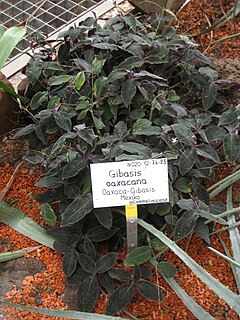
Maianthemum includes the former genus Smilacina and is a genus of perennial herbaceous flowering plant with fleshy, persistent rhizomes. It is widespread across much of North America, Europe and Asia, and may be terrestrial, aquatic or epiphytic. It is characterized by simple, unbranched stems that are upright, leaning or hanging down and have 2-17 foliage leaves. Leaves are simple and may clasp the stem or be short-petiolate. The inflorescence is terminal and either a panicle or a raceme with few to many pedicelate flowers. Most species have 6 tepals and 6 stamens; a few have parts in 4s. Tepals are distinct in most species and all of similar size. Flowers are spreading, cup-shaped or bell-shaped and usually white, but lavender to red or green in some species. Fruits are rounded to lobed berries containing few to several seeds.

Macleania is a genus of plants in the family Ericaceae.

Tournefortia, commonly known as soldierbush, is a genus of flowering plants in the borage family, Boraginaceae.

Galium californicum is a species of flowering plant in the coffee family known by the common name California bedstraw.

Galium divaricatum is a species of flowering plant in the coffee family known by the common name Lamarck's bedstraw.

Psychotria poeppigiana is a plant species in the family Rubiaceae; a common name is sore-mouth bush, though it is not very often used. This species is currently accepted as Palicourea tomentosa based on a journal article published in 2011.

Solanum lanceolatum, with the common names orangeberry nightshade and lanceleaf nightshade, is a species of nightshade. It is native to regions of South America, including the Cerrado ecoregion of the Tropical and subtropical grasslands, savannas, and shrublands biome, primarily in Brazil.
Henri Guillaume Galeotti was a French-Belgian botanist and geologist of Italian parentage born in Paris. He specialized in the study of the family Cactaceae.

Martin Martens was a Belgian botanist and chemist born in Maastricht, Netherlands.

Galium aparine, with common names including cleavers, clivers, catchweed and sticky willy among others, is an annual, herbaceous plant of the family Rubiaceae.

Callisia is a genus of flowering plants in the spiderwort family, Commelinaceae. Members of the genus are commonly known as roselings. It is native to the Western Hemisphere from the southern United States to Argentina. The generic name is derived from the Greek word καλλον (kallos), meaning "beauty."

Gibasis is a genus of flowering plants within the Commelinaceae family, first described in 1837. It is native to the Western Hemisphere from Texas and the West Indies south to Argentina, with most of the species native to Mexico.

Asplenium resiliens, the blackstem spleenwort or little ebony spleenwort, is a species of fern native to the Western Hemisphere, ranging from the southern United States south to Uruguay, including parts of the Caribbean. Found on limestone substrates, it is named for its distinctive purplish-black stipe and rachis. A triploid, it is incapable of sexual reproduction and produces spores apogamously. First described by Martens and Galeotti in 1842 under the previously used name Asplenium parvulum, the species was given its current, valid name by Kunze in 1844. Several similar species are known from the tropics; A. resiliens may have arisen from these species by reticulate evolution, but precise relationships among the group are not yet certain.
Galium aetnicum is a plant species in the Rubiaceae. The species is named for Mount Etna, the large and active volcano on the island of Sicily in the Mediterranean. The species is native to the island, and also to the Lazio and Abruzzo regions of mainland Italy. There are reports of the plant growing in Sardinia as well, but these are unconfirmed.
Spermacoce ovalifolia, the broadleaf false buttonweed, is a species of plants in the Rubiaceae. It is native to Mexico, Central America, parts of the Caribbean, and South America.
Laubertia, a genus of plants in the family Apocynaceae, was first described 1844. They are native to Mexico, Central America, and South America.

Quercus insignis is a Mesoamerican species of oak in the white oak section, within the beech family. It is native to southern Mexico and Central America, from Veracruz to Panamá.
Gyrandra is a genus of flowering plants in the family Gentianaceae, found in Texas, Mexico and Central America. Annual herbs, they are usually found in montane pine-oak forests.
Argyrochosma formosa is a fern known from eastern and central Mexico and Guatemala. It grows on rocky slopes, particularly on limestone. Unlike many members of the genus, it lacks white powder on the underside of its leaves. First described as a species in 1842, it was transferred to the new genus Argyrochosma in 1987, recognizing their distinctness from the "cloak ferns".
Lamourouxia is a genus of flowering plants belonging to the family Orobanchaceae.












